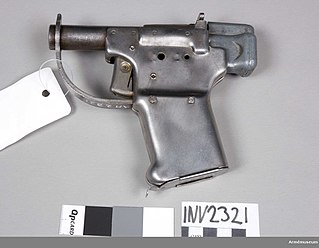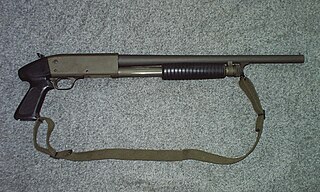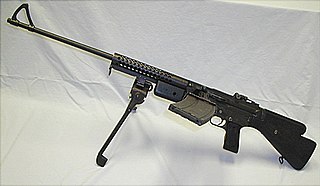 W
WThe Colt Model 1903 Pocket Hammerless is a .32 ACP caliber, self-loading, semi-automatic pistol designed by John Browning and built by Colt Patent Firearms Manufacturing Company of Hartford, Connecticut. The Colt Model 1908 Pocket Hammerless is a variant introduced five years later in .380 ACP caliber. Despite the title "hammerless", the Model 1903 does have a hammer. The hammer is covered and hidden from view under the rear of the slide, this allows the pistol to be carried in and withdrawn from a pocket quickly and smoothly without snagging.
 W
WThe Colt New Service is a large frame, large caliber, double-action revolver made by Colt from 1898 until 1941. Made in various calibers, the .45 Colt version with a 5½" barrel, was adopted by the U.S. Armed Forces as the Model 1909.
 W
WThe FP-45 Liberator is a pistol manufactured by the United States military during World War II for use by resistance forces in occupied territories. The Liberator was never issued to American or other Allied troops, and there are few documented instances of the weapon being used for its intended purpose; though the intended recipients, irregulars and resistance fighters, rarely kept detailed records due to the inherent risks if the records were captured by the enemy. Few FP-45 pistols were distributed as intended, and most were destroyed by Allied forces after the war.
 W
WThe Ithaca 37 is a pump-action shotgun made in large numbers for the civilian, military, and police markets. Based on a 1915 patent by firearms designer John Browning for a shotgun initially marketed as the Remington Model 17, it utilizes a novel combination ejection/loading port on the bottom of the gun which leaves the sides closed to the elements.
 W
WThe Lewis gun is a First World War–era light machine gun. Designed privately in America but not adopted, the design was finalised and mass-produced in the United Kingdom, and widely used by troops of the British Empire during the war. It had a distinctive barrel cooling shroud and top-mounted pan magazine. The Lewis served to the end of the Korean War, and was widely used as an aircraft machine gun during both World Wars, almost always with the cooling shroud removed, as air flow during flight offers sufficient cooling.
 W
WThe M1 carbine is a lightweight semi-automatic carbine that was a standard firearm for the U.S. military during World War II, the Korean War and the Vietnam War. The M1 carbine was produced in several variants and was widely used by paramilitary and police forces around the world, and also became a popular civilian firearm after World War II.
 W
WThe M1 Garand or M1 Rifle is a .30-06 caliber semi-automatic battle rifle that was the standard U.S. service rifle during World War II and the Korean War and also saw limited service during the Vietnam War. Most M1 rifles were issued to U.S. forces, though many hundreds of thousands were also provided as foreign aid to American allies. The Garand is still used by drill teams and military honor guards. It is also widely used by civilians for hunting, target shooting, and as a military collectible.
 W
WThe M2 machine gun or Browning .50 caliber machine gun is a heavy machine gun designed toward the end of World War I by John Browning. Its design is similar to Browning's earlier M1919 Browning machine gun, which was chambered for the .30-06 cartridge. The M2 uses the much larger and much more powerful .50 BMG cartridge, which was developed alongside and takes its name from the gun itself. It has been referred to as "Ma Deuce", in reference to its M2 nomenclature. The design has had many specific designations; the official US military designation for the current infantry type is Browning Machine Gun, Cal. .50, M2, HB, Flexible. It is effective against infantry, unarmored or lightly armored vehicles and boats, light fortifications, and low-flying aircraft.
 W
WThe M3 is an American .45-caliber submachine gun adopted for U.S. Army service on 12 December 1942, as the United States Submachine Gun, Cal. .45, M3. The M3 was chambered for the same .45 ACP round fired by the Thompson submachine gun, but was cheaper to produce and lighter, although, contrary to popular belief, it was less accurate. The M3 was commonly referred to as the "Grease Gun" or simply "the Greaser", owing to its visual similarity to the mechanic's tool.
 W
WThe M45 Quadmount was a weapon mounting consisting of four of the "HB", or "heavy barrel" .50 caliber M2 Browning machine guns mounted in pairs on each side of an open, electrically powered turret. It was developed by the W. L. Maxson Corporation to replace the earlier M33 twin mount. Although designed as an anti-aircraft weapon, it was also used against ground targets. Introduced in 1943 during World War II, it remained in US service as late as the Vietnam War.
 W
WThe .45 Reising submachine gun was manufactured by Harrington & Richardson (H&R) Arms Company in Worcester, Massachusetts, USA, and was designed and patented by Eugene Reising in 1940. The three versions of the weapon were the Model 50, the folding stock Model 55, and the semiautomatic Model 60 rifle. Over 100,000 Reisings were ordered during World War II, and were initially used by the United States Navy, Marine Corps, and the United States Coast Guard, though some were shipped to Canadian, Soviet, and other allied forces to fight the Axis powers.
 W
WThe M1903 Springfield, officially the United States Rifle, Caliber .30-06, Model 1903, is an American five-round magazine fed, bolt action service repeating rifle, used primarily during the first half of the 20th century.
 W
WThe M1917 Enfield, the "American Enfield", formally named "United States Rifle, cal .30, Model of 1917" is an American modification and production of the .303-inch Pattern 1914 Enfield (P14) rifle, which was developed and manufactured during the period 1917–1918. Numerically, it was the main rifle used by the American Expeditionary Forces in Europe during World War I. The Danish Sirius Dog Sled Patrol on Greenland still use the M1917, which performs reliably in Arctic conditions, as their service weapon.
 W
WThe M1917 Revolvers were six-shot, .45 ACP, large frame revolvers adopted by the United States Military in 1917, to supplement the standard M1911 pistol during World War I. There were two variations of the M1917, one made by Colt and the other by Smith & Wesson. They used moon-clips to hold the cartridges in position, facilitate reloading, and to aid in extraction since revolvers had been designed to eject rimmed cartridges and .45 ACP rounds were rimless for use with the magazine-fed M1911. After World War I, they gained a strong following among civilian shooters. A commercial rimmed cartridge, the .45 Auto Rim, was also developed, so M1917 revolvers could eject cartridge cases without using moon-clips.
 W
WThe M1919 Browning is a .30 caliber medium machine gun that was widely used during the 20th century, especially during World War II, the Korean War, and the Vietnam War. The M1919 saw service as a light infantry, coaxial, mounted, aircraft, and anti-aircraft machine gun by the U.S. and many other countries.
 W
WThe M1941 Johnson Light Machine Gun, also known as the Johnson and the Johnny gun, was an American recoil-operated light machine gun designed in the late 1930s by Melvin Johnson. It shared the same operating principle and many parts with the M1941 Johnson rifle and the M1947 Johnson auto carbine.
 W
WThe Sedgley OSS .38 glove pistol or Sedgley Fist Gun is a World War II firearm. It was designed by Stanley M. Haight and manufactured by Sedgley Co. of Philadelphia for the U.S. Marines and the U.S. Navy. Its official designation by the US Navy was Hand Firing Mechanism, Mk 2.
 W
WThe Thompson submachine gun is a blowback-operated, air-cooled, magazine-fed selective-fire submachine gun, invented by the United States Army Brigadier general John T. Thompson in 1918. It was originally designed to break the stalemate of trench warfare of World War I, but was not finished until after the war ended.